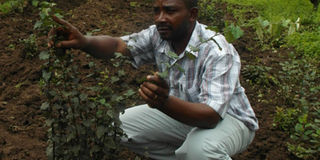Researchers develop apple seedlings to benefit farmers

Hadad Rukundo, a crop technologist at Kazardi, shows the different methods of getting apple seedlings from the root stock. PHOTOS BY ROBERT MUHEREZ
What you need to know:
Kabale is the part of Uganda known for growing for apples but while this has been done for years, there were challenges to overcome.
Kachwekano Zonal Agricultural Research and Development Institute (Kazardi) is generating apple seedlings to satisfy increasing demand in Uganda and Rwanda and to overcome the challenges of importing seed from Germany. The latter is not only expensive but is also not sustainable.
Hadad Zim Rukundo, a crop technologist at Kazardi, says that two methods; ground layering and stooling, are being employed for apple seed multiplication. The station currently produces about 10,000 seedlings annually.
“We have been depending on importing the apple seeds from Germany but because of the high costs involved, we have decided to produce our own and multiply it to benefit many farmers. One kilogramme of apple seed is sold at Shs1.3m and it generates about 25,000 seedlings. Through ground layering or stooling methods, we generate about eight root stocks from one imported seedling thus making 200,000 seedlings from one kilo of imported apple seeds,” Rukundo explains.
He adds that a seed apple is left to grow to about two metres high, then it is bent and buried in the soil after a hardening process of about two weeks to prevent it from rotting.
After a period of about two months, about eight spouts develop on the buried stem and they are left for up to six months to mature before they are generated into seedlings.
The apple seeds generated from this root stock are then grafted before they are given to farmers for planting. Each grafted seedling costs Shs6,000.
Better methods
Rukundo says that local governments, NGOs and individuals in different parts of Uganda are the main buyers of the apple seedlings. Also, farmers from Rwanda have also started ordering for the seedlings from the research station.
Rogers Akatwijuka, regional Naads coordinator for Kigezi, says that a total of 120 farmers are involved in apple growing in the region.
Of them, what are known as model farmers are currently earning about Shs68m per year. One acre holds up to 340 apple trees and each fruit goes for Shs500 at farm gate.
Akatwijuka also reveals that the programme is working with the crop technologists at Kazardi to develop methods on protecting apples from being eaten by birds and also ensuring that their texture is as fine as those imported from South Africa.
“We are currently popularising fruit bagging as a measure to prevent the apples from injuries and also the direct sunlight that creates a rough texture on the fruit,” Akatwijuka says. “We advising farmers to use the ordinary rough papers,”
Can apples really be grown in the tropics?
It is a shock to many people that apples can be grown in a tropical climate, and have been grown for decades. This goes against the conventional wisdom that apples need between 800-1,000 hours below 7°C (45°F.) in order to break dormancy and set fruit.
But experience has shown that using tropic apple culture methods, the tree will blossom and fruit.
You still must be choosy about which varieties to plant, and the tree will act much different than in a cold climate, but the end result is crisp, juicy, tasty apples.
It was then assumed that apples could be grown only in the highland tropic areas that receive a bit of cold weather, but not in the lowlands with the heat and humidity.
However a three-year study in Nigeria and Cameroon proved that this was wrong. In that study, 18 localities in Nigeria and eight in Cameroon, comprising both cool highlands and hot tropic lowlands, were selected and planted with the apple variety, Anna, and a pollinator.
Several different cultural methods such as planting density and irrigation were employed at each location and an evaluation of the fruit pack-out was done at the completion.
Researchers were surprised to find that some of the warmer lowland areas produced well, and the limiting factor was not temperature, but excessive rainfall.
Heavy rains during blossoming prevented pollinating insects from flying, knocked the flower petals and young fruitlets off the tree, and led to problems with foliar disease such as powdery mildew and scab. Better results were obtained in areas with less rainfall but with the potential for irrigation.
So when people ask if apples can be grown in their area, I suggest to plant a test plot of 10-20 varieties to see how they perform.
Soil and rainfall conditions can vary widely in a small area, and so the variables cannot be fully known until you stick some trees in the ground and see what happens.
Do not believe anybody who tells you it cannot be done unless they have actually tried it (I used to believe them for years, and they were wrong, very wrong).
However, do realise that any time you are planting a new crop in an area, it should be considered entirely speculative, and you should be prepared to absorb a 100 per cent loss.
Often this happens several times until the right methodology is found that fits your unique set of challenges and growing conditions. There is always some pest, disease, or soil deficiency to deal with; even growers in cold climates suffer losses and very often have years when they have a poor or no harvest.
Source: Kuffel Creek Apple Nursery




